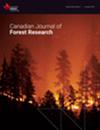Can partial-cut harvesting be used to extend the availability of terrestrial forage lichens in late-seral pine-lichen woodlands? Evidence from the Lewes Marsh (southern Yukon) silvicultural systems trial.
IF 1.5
3区 农林科学
Q2 FORESTRY
引用次数: 0
Abstract
In northern British Columbia and southern Yukon woodland caribou forage extensively on terrestrial lichens, predominately mat-forming Cladina species in late-successional pine-lichen woodlands. Many of these stands are now reaching a point in their development where lichen abundance declines as feather-moss mats increase. We evaluated the response of forest floor plant communities in pine-lichen woodlands from the southern Yukon Lewes Marsh partial-cutting trial eight years after harvesting. Photoplot results documented a major decline (>60% ± 5.6% S.E.) in the mean surface area of existing large clumps of C. mitis in control (unharvested) treatments, whereas mean surface area of large C. mitis clumps declined by 28% (± 15% S.E.) in the one-third basal-area removal, and showed an increase of 13.5% (± 25% S.E.) in the two-third’s basal-area removal. Line-intercept transects documented no changes in overall stand-level lichen abundance between pre- (2012) and post-harvest (2021) measurements, while feather-moss mats and dwarf shrubs showed declines and increases respectively in partial-cutting harvest plots. Stand thinning may provide a bridging strategy to extend the period of forage lichen availability in late-seral pine-lichen woodlands, an important consideration in landscapes where increasing severity and frequency of fires is changing the seral-state distribution of caribou habitat.部分砍伐是否可用于延长晚期原生松树-地衣林地中陆生饲料地衣的可用性?来自路易斯沼泽(育空地区南部)造林系统试验的证据。
在不列颠哥伦比亚省北部和育空地区南部的林地中,驯鹿大量觅食陆生地衣,主要是在晚期松树-地衣林地中形成垫状的 Cladina 物种。这些林地中的许多现在已经发展到地衣丰度随着羽毛苔藓垫的增加而下降的阶段。我们评估了南部育空路易斯沼泽部分砍伐试验中松树-地衣林地的林地植物群落在砍伐八年后的反应。光照图结果表明,在对照组(未采伐)处理中,现有的大块松毛虫平均表面积大幅下降(>60% ± 5.6% S.E.),而在基部面积去除三分之一的处理中,大块松毛虫平均表面积下降了 28% (± 15% S.E.),在基部面积去除三分之二的处理中,大块松毛虫平均表面积增加了 13.5% (± 25% S.E.)。线截线横断面记录表明,在采伐前(2012 年)和采伐后(2021 年)的测量结果之间,林分地衣的总体丰度没有变化,而在部分砍伐的地块中,羽毛苔藓垫和矮灌木的丰度分别出现了下降和上升。在火灾的严重程度和频率不断增加并正在改变驯鹿栖息地的序列状态分布的地貌中,林分疏伐可能是延长晚生松树-地衣林地饲料地衣供应期的一种过渡策略,这也是一个重要的考虑因素。
本文章由计算机程序翻译,如有差异,请以英文原文为准。
求助全文
约1分钟内获得全文
求助全文
来源期刊
CiteScore
4.20
自引率
9.10%
发文量
109
审稿时长
3 months
期刊介绍:
Published since 1971, the Canadian Journal of Forest Research is a monthly journal that features articles, reviews, notes and concept papers on a broad spectrum of forest sciences, including biometrics, conservation, disturbances, ecology, economics, entomology, genetics, hydrology, management, nutrient cycling, pathology, physiology, remote sensing, silviculture, social sciences, soils, stand dynamics, and wood science, all in relation to the understanding or management of ecosystem services. It also publishes special issues dedicated to a topic of current interest.

 求助内容:
求助内容: 应助结果提醒方式:
应助结果提醒方式:


